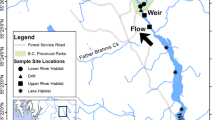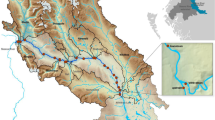Abstract
A critical challenge for ecologists is to understand the functional significance of habitat heterogeneity and connectivity for mobile animals. Here, we explore how a thermo-regulating fish responds to annual variation in the spatial patterning of thermal and trophic resources. In a third-order stream in coastal Alaska, juvenile coho salmon forage on sockeye salmon eggs at night in cold water and then move to warmer water to increase their digestive capacity. We mapped the spatial distributions of water temperature, juvenile coho salmon, and spawning sockeye salmon across a 5-year period during which summer discharge varied by greater than fivefold. In low flow years, warm water (9–12°C) was only available in thalweg (that is, main-channel) habitat at least approximately 400 m upstream of the cooler habitat (3–7°C) where sockeye salmon spawned. In high flow years, the entire stream thalweg was isothermal at 7–8°C, but inundated off-channel areas generated warm habitats (9–12°C) laterally adjacent to the downstream regions where sockeye salmon spawned. The daytime spatial distribution of juvenile coho salmon shifted from headwater thalweg habitats in low flow years, to downstream off-channel habitats in high flow years. In all years, the majority of juvenile coho salmon sampled during the daytime were found in warm habitat units without sockeye salmon present, yet they exhibited diet contents comprised virtually entirely of sockeye salmon eggs. Thus, thermoregulatory movements by coho salmon were able to track an annually shifting mosaic of water temperature. Our results demonstrate how the spatial habitat heterogeneity and connectivity of intact floodplains can in turn buffer aquatic organisms from high levels of temporal variation in habitat conditions and resource abundance.




Similar content being viewed by others
References
Armstrong JB, Bond MH. 2013. Phenotype flexibility in wild fish: Dolly Varden regulate assimilative capacity to capitalize on annual pulsed subsidies. J Animal Ecol. doi:10.1111/1365-2656.12066.
Armstrong JB, Schindler DE. 2011. Excess digestive capacity in predators reflects a life of feast and famine. Nature 476:84–7.
Armstrong JB, Schindler DE, Bentley KT, Brooks GT, Ruff CP, Torgersen CE. 2013. Juvenile fish exploit heterogeneity in thermal and trophic resources through diel horizontal migrations in streams. Ecology (in press).
Armstrong JB, Schindler DE, Omori KL, Ruff CP, Quinn TP. 2010. Thermal heterogeneity mediates the effects of pulsed subsidies across a landscape. Ecology 91:1445–54.
Baxter CV, Hauer FR. 2000. Geomorphology, hyporheic exchange, and selection of spawning habitat by bull trout (Salvelinus confluentus). Canadian Journal of Fisheries and Aquatic Sciences 57:1470–81.
Beechie TJ, Sear DA, Olden JD, Pess GR, Buffington JM, Moir H, Roni P, Pollock MM. 2010. Process-based principles for restoring river ecosystems. Bioscience 60:209–22.
Bentley KT, Schindler DE, Armstrong JB, Ruff CP, Lisi PJ. 2012. Inter-annual variation in a pulsed resource subsidy mediates the foraging and growth response of stream-dwelling salmonids. Ecosphere 3(12):113.
Bisson PA, Sullivan K, Nielsen JL. 1988. Channel hydraulics, habitat use, and body form of juvenile coho salmon, steelhead, and cuttroat trout in streams. Trans Am Fish Soc 117:262–73.
Brandt SB, Mason DM, Patrick EV. 1992. Spatially-explicit models of fish growth-rate. Fisheries 17:23–35.
Breau C, Cunjak RA, Peake SJ. 2011. Behaviour during elevated water temperatures: can physiology explain movement of juvenile Atlantic salmon to cool water? J Animal Ecol 80:844–53.
Brett JR. 1971. Energetic responses of salmon to temperature: study of some thermal relations in physiology and freshwater ecology of sockeye salmon (Oncorhynchus nerka). Am Zool 11:99–113.
Buchanan TJ, Somers WP. 1969. Discharge measurements at gaging stations. Techniques of Water-Resources Investigations Reports. Washington, DC: U.S. Government Printing Office.
Campana SE, Dorey A, Fowler M, Joyce W, Wang ZL, Wright D, Yashayaev I. 2011. Migration pathways, behavioural thermoregulation and overwintering grounds of blue sharks in the Northwest Atlantic. Plos One 6(2):e16854.
Denton KP, Rich HB, Quinn TP. 2009. Diet, movement, and growth of Dolly Varden in response to sockeye salmon subsidies. Trans Am Fish Soc 138:1207–19.
Elliott JM, Persson L. 1978. Estimation of daily rates of food consumption for fish. J Animal Ecol 47:977–91.
Fausch KD, Torgersen CE, Baxter CV, Li HW. 2002. Landscapes to riverscapes: bridging the gap between research and conservation of stream fishes. Bioscience 52:483–98.
Fryxell JM, Wilmshurst JF, Sinclair ARE, Haydon DT, Holt RD, Abrams PA. 2005. Landscape scale, heterogeneity, and the viability of Serengeti grazers. Ecol Lett 8:328–35.
Gilbert JJ, Hampton SE. 2001. Diel vertical migrations of zooplankton in a shallow, fishless pond: a possible avoidance–response cascade induced by notonectids. Freshw Biol 46:611–21.
Glodek GS. 1978. The importance of catfish burrows in maintaining fish populations of tropical freshwater streams in western Ecuador. Fieldiana Zool 73:1–8.
Hilborn R, Quinn TP, Schindler DE, Rogers DE. 2003. Biocomplexity and fisheries sustainability. Proc Natl Acad Sci USA 100:6564–8.
Hohausova E, Copp GH, Jankovsky P. 2003. Movement of fish between a river and its backwater: diel activity and relation to environmental gradients. Ecol Freshw Fish 12:107–17.
Holtby LB, Andersen BC, Kadowaki RK. 1990. Importance of smolt size and early ocean growth to interannual variability in marine survival of coho salmon (Oncorhynchus kisutch). Can J Fish Aquat Sci 47:2181–94.
Huey RB. 1991. Physiological consequences of habitat selection. Am Nat 137:S91–115.
Junk WJ, Bayley PB, Sparks RE. 1989. The flood pulse concept in river–floodplain systems. Can Special Publ Fish Aquat Sci 106:110–27.
Lorenz JM, Filer JH. 1989. Spawning habitat and redd characteristics of sockeye salmon in the glacial Yaku river, British Columbia and Alaska. Trans Am Fish Soc 118:495–502.
Lytle DA, Poff NL. 2004. Adaptation to natural flow regimes. Trends Ecol Evol 19:94–100.
Malard F, Tockner K, Ward JV. 2000. Physico-chemical heterogeneity in a glacial riverscape. Landsc Ecol 15:679–95.
Mantua NJ, Hare SR. 2002. The Pacific decadal oscillation. J Oceanogr 58:35–44.
Mertes LAK, Daniel DL, Melack JM, Nelson B, Martinelli LA, Forsberg BR. 1995. Spatial patterns of hydrology, geomorphology, and vegetation on the floodplain of the Amazon river in Brazil from a remote-sensing perspective. Geomorphology 13:215–32.
Muhlfeld CC, Glutting S, Hunt R, Daniels D, Marotz B. 2003. Winter diel habitat use and movement by subadult bull trout in the upper Flathead River, Montana. North Am J Fish Manage 23:163–71.
Narver DW. 1970. Diel vertical movements and feeding of under yearling sockeye salmon and limnetic zooplankton in Babine Lake, British Columbia. J Fish Res Board Can 27:281–316.
Nickelson TE, Rodgers JD, Johnson SL, Solazzi MF. 1992. Seasonal changes in habitat use by juvenile coho salmon (Oncorhynchus kisutch) in Oregon coastal streams. Can J Fish Aquat Sci 49:783–9.
Orians GH, Pearson NE. 1979. On the theory of central place foraging. Analysis of ecological systems. Columbus: Ohio State University Press. pp 155–77.
Poff NL, Olden JD, Merritt DM, Pepin DM. 2007. Homogenization of regional river dynamics by dams and global biodiversity implications. Proc Natl Acad Sci USA 104:5732–7.
Quinn TP, Peterson NP. 1996. The influence of habitat complexity and fish size on over-winter survival and growth of individually marked juvenile coho salmon (Oncorhynchus kisutch) in Big Beef creek, Washington. Can J Fish Aquat Sci 53:1555–64.
Quinn TP, Volk EC, Hendry AP. 1999. Natural otolith microstructure patterns reveal precise homing to natal incubation sites by sockeye salmon (Oncorhynchus nerka). Can J Zool 77:766–75.
Reeves GH, Benda LE, Burnett KM, Bisson PA, Sedell JR. 1995. A disturbance-based ecosystem approach to maintaining and restoring freshwater habitats of evolutionarily significant units of anadromous salmonids in the Pacific Northwest. Am Fish Soc Symp 17:334–49.
Rinella DJ, Wipfli MS, Stricker CA, Heintz RA, Rinella MJ. 2012. Pacific salmon (Oncorhynchus spp.) runs and consumer fitness: growth and energy storage in stream-dwelling salmonids increase with salmon spawner density. Can J Fish Aquat Sci 69:73–84.
Rogers LA, Schindler DE. 2011. Scale and the detection of climatic influences on the productivity of salmon populations. Glob Chang Biol 17:2546–58.
Ruff CP, Schindler DE, Armstrong JB, Bentley KT, Brooks GT, Holtgrieve GW, McGlauflin MT, Torgersen CE, Seeb JE. 2011. Temperature-associated population diversity in salmon confers benefits to mobile consumers. Ecology 92:2073–84.
Rypel AL, Pounds KM, Findlay RH. 2012. Spatial and temporal trade-offs by bluegills in floodplain river ecosystems. Ecosystems 15:555–63.
Scheuerell MD, Moore JW, Schindler DE, Harvey CJ. 2007. Varying effects of anadromous sockeye salmon on the trophic ecology of two species of resident salmonids in southwest Alaska. Freshw Biol 52:1944–56.
Schindler DE, Hilborn R, Chasco B, Boatright CP, Quinn TP, Rogers LA, Webster MS. 2010. Population diversity and the portfolio effect in an exploited species. Nature 465:609–12.
Stanford JA, Lorang MS, Hauer FR. 2005. The shifting habitat mosaic of river ecosystems. Verh Internat Verein Limnol 29:123–36.
Tockner K, Malard F, Burgherr P, Robinson CT, Uehlinger U, Zah R, Ward JV. 1997. Physico-chemical characterization of channel types in a glacial floodplain ecosystem (Val Roseg, Switzerland). Arch Hydrobiol 140:433–63.
Tockner K, Malard F, Ward JV. 2000. An extension of the flood pulse concept. Hydrol Proc 14:2861–83.
Tonolla D, Acuna V, Uehlinger U, Frank T, Tockner K. 2010. Thermal heterogeneity in river floodplains. Ecosystems 13:727–40.
Torgersen CE, Price DM, Li HW, McIntosh BA. 1999. Multiscale thermal refugia and stream habitat associations of chinook salmon in northeastern Oregon. Ecol Appl 9:301–19.
Whited DC, Lorang MS, Harner MJ, Hauer FR, Kimball JS, Stanford JA. 2007. Climate, hydrologic disturbance, and succession: drivers of floodplain pattern. Ecology 88:940–53.
Wigington PJ Jr, Ebersole JL, Colvin ME, Leibowitz SG, Miller B, Hansen B, Lavigne HR, White D, Baker JP, Church MR, Brooks JR, Cairns MA, Compton JE. 2006. Coho salmon dependence on intermittent streams. Frontiers Ecol Environ 4:513–18.
Wipfli MS, Hudson JP, Caouette JP, Chaloner DT. 2003. Marine subsidies in freshwater ecosystems: salmon carcasses increase the growth rates of stream-resident salmonids. Trans Am Fish Soc 132:371–81.
Wurtsbaugh WA, Neverman D. 1988. Post-feeding thermotaxis and daily vertical migration in a larval fish. Nature 333:846–8.
Acknowledgments
This study was a contribution of the University of Washington Alaska Salmon Program, funded by the Gordon and Betty Moore Foundation, the National Science Foundation, the Alaska salmon processors, and the School of Aquatic and Fishery Sciences. We thank the many individuals who assisted with fieldwork, contributed equipment, or helped with data analysis. Two anonymous reviewers provided helpful commentary to improve this manuscript.
Author information
Authors and Affiliations
Corresponding author
Additional information
Author contributions
JA: Conceived project, executed research, and wrote first draft of manuscript. DS: Advised and contributed to all stages of project.
Rights and permissions
About this article
Cite this article
Armstrong, J.B., Schindler, D.E. Going with the Flow: Spatial Distributions of Juvenile Coho Salmon Track an Annually Shifting Mosaic of Water Temperature. Ecosystems 16, 1429–1441 (2013). https://doi.org/10.1007/s10021-013-9693-9
Received:
Accepted:
Published:
Issue Date:
DOI: https://doi.org/10.1007/s10021-013-9693-9




